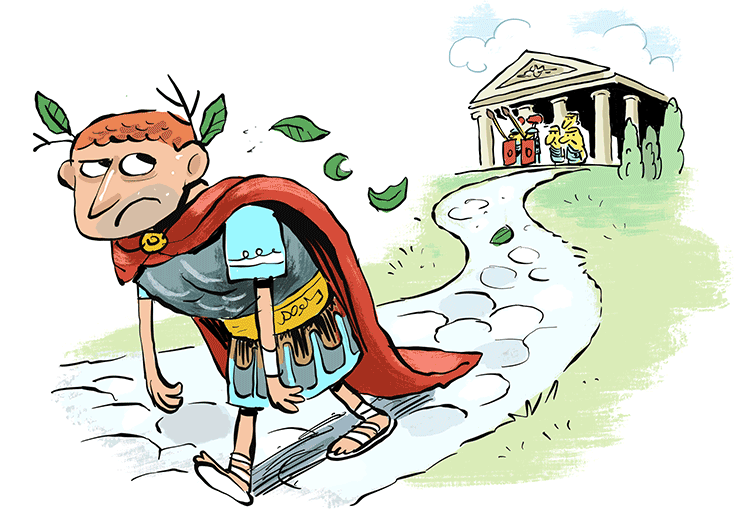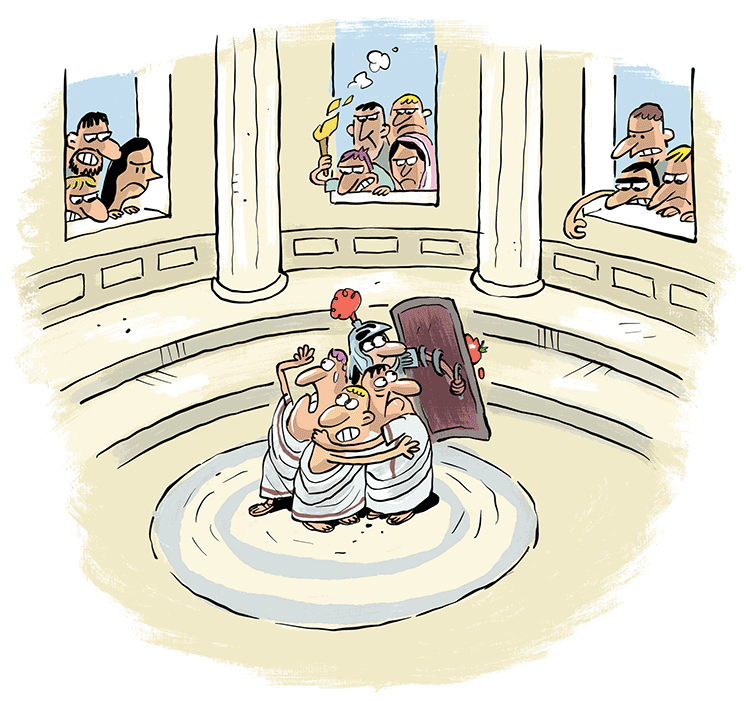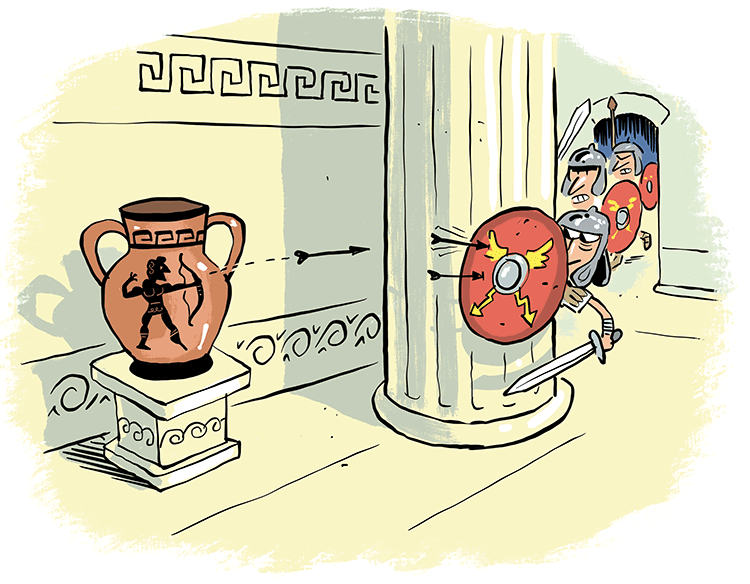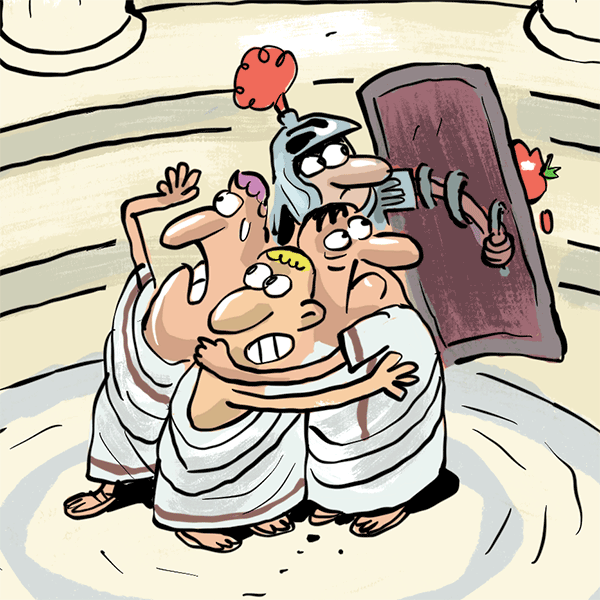By the end of the 6th century BC, so around 500 BC, the city of Rome had gone from a small settlement along the Tiber River to a city with considerable local influence. During these 200 years of initial growth, however, kings ruled Rome.
They held absolute power over the state, set the laws, dealt with the military, and commanded the respect and wealth of the people.
Well, at least in theory they did.
The First Senate
In reality, from the beginning, power in Rome belonged to the Senate, a group of the most powerful and wealthiest Roman citizens. This Senate was actually set up by Romulus, the first king and supposed founder of Rome.
In the beginning, the Senate didn’t have much power when it came to the affairs of the state. Instead, it was there to advise. But the Senate still most certainly had power: it was the group that elected the king.
This process was set up by Romulus, who thought Rome should choose its next leader based on merit and not on blood.
Over time, though, the Senate grew increasingly powerful. Many wanted the Senate to rule Rome, but they didn’t get the chance to make this dream a reality until 509 BC

Overthrowing the Monarchy
Throughout history, king’s have often let their power go to their heads. Their supremacy over others leads them to believe they are above the law.
Well, the last Roman king, Lucius Tarquinis Superbus, aka Tarquin, found out the hard way that this is not true. After raping a noblewoman named Lucreita, the Senate voted to remove him from his position and banish him from the city.
What’s more, they took this opportunity to get rid of the position of king altogether.
In its place, they created the position of consul. Well, there were actually two, and these individuals were elected by the Senate each year. Together, they had many of the same powers as the king. But since they were elected every year, it was much better for them to follow the advice presented to them by the Senate. Something the king never had to bother with.
This move by the Senate in 509 BC converted Rome from a monarchy into a republic and launched a new era of Roman history. From this point on, Rome would continue to grow, fighting its way to the top of the ancient world.
A State of Constant War
The switch from a monarchy to a republic brought about considerable changes in Rome. But it most certainly did not bring about stability. In fact, during the 450 years or so of the Roman Republic, Rome was at war constantly.
First, it fought locally to assert itself as the dominant city on the Italian peninsula, but then it looked further afield. In this process, Rome became increasingly imperial, and the Republic itself struggled.
Still, these conflicts helped define early Roman history and make it easier to understand how and why things developed later on.
Conquering Rome: the Conflict of the Order
After kicking out the king and taking control of Rome, the Senate almost immediately faced an internal crisis. First, it had to defend its decision to abolish the monarchy.
Apparently Tarquin didn’t like being banished, and so he tried to rally support to retake his throne. The Senate was then forced to summon an army to suppress him, which they did. First item of business, done!
The next internal conflict had to do with how Rome was organized.
Officially, there were two main classes: patricians and plebeians. The Patricians, where the word “patron” comes from, were the wealthy landowners. They made up a relatively small percentage of the population yet held all the political power. In fact, in the early days of the Republic, to hold any political office at all, you had to belong to the patrician class.
The Plebeian class, often referred to as the “plebs,” was made up of pretty much everyone else: the commoners; regular folk.
A Very Unequal Rome
Plebs did not have access to political office and were also treated fairly poorly.
For example, the Senate could pass laws that affected the plebs, not tell them, and then arrest them and punish them anyway.
Plebs also had to pay lots of taxes and were restricted in how much property they could own, meaning that many of them were burdened by excessive debt around the time the monarchy was abolished.
And as if this weren’t bad enough, your status as a Plebeian was determined by birth. If your parents were plebs, so were you. Nothing you could do about it.
The same was the case for patricians, but few were complaining about this.
This inequality eventually erupted into social unrest, launching a two-century long conflict known as “The Conflict of the Orders.”

The Plebeian Tribune
In this conflict, the Plebeians continuously fought for more political participation, and they eventually won it. The first concession came in 494 BC, just a little more than a decade after the emergence of the Republic, with the creation of the Plebeian Tribune.
This position, which was elected by the plebs, represented the Plebeians in the government. They could summon the Senate and propose legislation, but they could also veto laws made by the Senate and the Consuls.
Such power meant that the patricians could no longer ignore the wills and needs of the Plebeian class.
Establishing the Tribune helped to quell the conflict a bit, but throughout the period of the Roman Republic, the patricians were forced to give more and more power to the Plebeians. Eventually, by the 3rd century BC, Plebeians could run for all political offices, and the distinction between the two classes became all but meaningless.
Conquering Italy
At the same time Rome was dealing with these internal conflicts, it was also fighting with the Etruscans for control of the Italian peninsula.
Initially, this war may have started out as self-defense. With the king gone, it’s likely the Etruscans attacked to try and seize the opportunity.
But soon thereafter, Rome became increasingly aggressive. Throughout the fourth and fifth century BC, Rome fought several wars with the Samites (located mostly to the east and south of Rome) and the Etruscans (located mainly to the north).
Later, as part of another conflict, the Romans fought the Celtic tribes in northern Italy. The Celts are an ancient cultural group who may have originated in central Europe but who emigrated all over the ancient world, from Spain to Albania and beyond.
All in all, by 218 BC, just under 300 years since the birth of the Republic, Rome had expanded to control all of what we now call Italy. Now, time to go even further!
Punic Wars
Rome’s growth in Italy did not go unnoticed by its international neighbors, particularly the Carthaginians, who had used their base in Carthage, located in modern-day Tunisia, to dominate much of the Mediterranean world.
Seeing the growth of Rome as a threat, particularly to their settlements on Sicily and Sardinia, the two islands off the “toe” of the Italian peninsula, Carthage pushed back. But this led to war, and things did not go well for the Carthaginians.
In total, there were three Punic Wars. The first was fought from 264 BC — 241 BC, the second from 218 BC to 201 BC, and the third, which resulted in Carthage’s total destruction, took place from 149 — 146 BC.
Based on the length of these first two conflicts, it’s easy to see how these two powers were evenly matched, and also how this was one of the bloodiest conflicts of the ancient world.
In the end, though, Rome emerged victorious, adding much of northern Africa to its realm. In addition to this, it helped Rome establish itself as the premier power in the Mediterranean. From this position, Rome could expand even further, bringing it even closer to becoming an empire.
Macedonian Wars
After winning the Second Punic War, the Romans were feeling pretty good. And for good reason; they had just subdued the most powerful civilization in the Mediterranean. But instead of resting on their success, they set out for more. The target: Macedonia and the Greek world.
Macedonia is a region in northern Greece. It’s the birthplace of Alexander of Macedon, aka Alexander the Great. He conquered everyone from Greece to India, and when he died, three kingdoms emerged: Macedonia in Greece, Ptolemaic Egypt, and the Seleucid Empire, which stretched roughly from modern-Iran east to Afghanistan.
Eventually, Rome would conquer all of these. But the first one it targeted was Macedonia.
The kingdom in charge of mainland Greece, and a culture the Romans respected and admired, it’s obvious why Rome wanted to conquer Macedonia. They faced off starting in 241 BC and went on to fight four total wars until the Romans finally emerged victorious in 148 BC.
The last of these wars was fought between Rome and the Seleucid Empire and left Rome with control over much of modern-day Turkey and the surrounding lands.

Building a Greco-Roman World
Victory over Macedon brought Greece fully into the control of the Roman Republic. Many of its cities were destroyed or abandoned, particularly Sparta and Corinth. But Corinth was rebuilt and made into the capital of the new Roman province: Achaea. Northern Greece, the part including Macedon, was also made into a province named Epirus.
The Macedonian Wars were significant because they not only expanded Roman territory considerably but they brought many more people under Roman control.
The only issue with this, however, was that these people spoke Greek; the Greek empires of previous centuries had made the Greek language standard in much of the ancient world.
For this reason, the Romans had to start incorporating more and more aspects of Greek culture. Greek gods were made Roman, myths were intertwined, and Greek became an official language of the Roman government. In fact, throughout much of Roman history, it would have been just as common to hear Greek spoken in Rome as Latin.
Civil Wars
In addition to all these wars the Roman Republic was fighting with its neighbors both near and far, it also had its fair share of civil conflict. First there was the Conflict of the Orders, which pitted the upper and lower classes against one another. Slave rebellions were also frequent, and powerful Roman magistrates often fought with one another.
A reason for this was that Roman politicians gained fame and prestige, and through this, power, by achieving and accomplishing things in the name of Rome. In most cases, this meant conquering new lands.
This emphasis on individual achievement made it less and less appealing for Roman politicians to work together. Often, conflicts would escalate, and civil war would erupt.
Conflict also emerged as a result of Rome’s growth. As it expanded its borders, it became more and more powerful. Fights broke out over who would govern these new territories and benefit from their riches, and since Rome was constantly expanding during this period, these fights were endless.
All in all, by the last century BC, Rome was in turmoil. The word “unstable” doesn’t even do justice to what was happening. Not one, nor two, but three separate slave revolts broke out in the 3rd century BC, and in the 4th, the then-recently conquered Falisci people, who lived in Northern Italy near modern-day Austria, also rebelled and launched another civil war.
On top of this, Roman Senators and generals were often competing with one another for political power, and these conflicts often turned violent.
But, eventually, through another war (shocker), things would settle down. And in the process, a new era of Roman history was born.
The Fall of the Republic
By the year 59 BC, Rome was so corrupt it hurt. The Senate was controlled almost entirely by three men, Julius Caesar, Pompey, and Crassus, all of whom are out for themselves. Eventually, Pompey dies, and Caesar and Crassus go to war for control of Rome.
In 47 BC, Caesar emerged victorious and was named dictator perpetuo, which means dictator for life.
No more consuls elected every year. And, pretty much, no more Senate.
Just like that, the Roman Republic, which lasted for 450 years, was no more. It was now time for the Roman Empire.
So Much War…For What?
This first period of Roman history, from 409 BC to 47 BC, was a period of great expansion but also tremendous violence. War was a near constant fact of life. But why? Why were the Romans so obsessed with violence?
Staying Alive
In the beginning, war was simply a necessity for survival. Although the exact conditions that led to the founding of Rome remain unclear, it’s likely that the Latin tribes previously controlled by the Etruscans moved south throughout Italy to escape attack or perhaps even persecution.
Centuries of violence between these two groups (back then, being different was often enough motivation for war) had turned the Romans into a highly militaristic people. Fighting the other tribes on the Italian peninsula was often simply a matter of avoiding being conquered. But once the Romans realized their dominance, they had no interest in stopping.
A Growing Military Tradition and a Thirst for Conquest
So, after conquering their Italian foes Rome had developed a strong military tradition, one that used fear and violence to subjugate its enemies, as well as a healthy appetite for war. Therefore, instead of stopping in Italy, the Romans did what all great ancient civilizations did on the heels of military success: they kept fighting.
Expansion has always been at the heart of human civilization. Once your borders are secure, it’s natural to see what else you can control.
For the Romans, this meant expanding into North Africa, Europe (mostly modern-day France and Spain) and western Asia, where they would encounter other powerful civilizations — Carthage, Egypt, Greece, etc.
These cultures learned to work together at times, but they often had competing interests when it came to land. And in ancient times, these disputes were almost always settled on the battlefield.
Later, Rome got more aggressive in its military efforts. For example, in the second century BC, Rome picked a fight with Carthage hoping to take control of Sicily and also seize control of Mediterranean trade. At the time, Carthage was the dominant civilization in the Mediterranean, and as Rome’s power grew, this situation became increasingly unacceptable.
Trade, Tribute, and a Culture of War
This brings us to another motivation for war: money.
By conquering lands, Rome could demand taxes and tributes from those they defeated. And they could also take control of the resources once controlled by their beaten foes.
Lastly, war was a huge part of Roman culture. The Romans saw their city as the greatest in the world (or at least what they knew of it back then) and wanted to spread this greatness as far and as wide as they could.
Plus, the story of how Rome founded is steeped in war, starting from the presence of Mars, the god of war, as the father of Rome’s founding brothers, Romulus and Remus, the latter of which died at the hands of his brother over a dispute about where they should found their new city.
This love for violence and war can be seen in how the Romans entertained themselves: by watching brutal fights to the death between slaves, known as gladiators.
Furthermore, conquering lands in the name of Rome brought tremendous glory and honor to military commanders, and soldiers who fought in foreign wars were held in high esteem. Dying for Rome was one of the most glorious ways an Ancient Roman could meet their maker.
All of these factors, plus the growing supremacy of the Roman army as compared to its neighbors, made all the tragedy and violence of war more than worth it for the ancient Romans. And in the end, this thirst for war and conquest helped the Roman Republic considerably expand its borders.
From there, the empire that would change the world forever was born.
Was it all worth it? Well, we’ll leave that question up to you.
Written by Matthew Jones
Illustrated by Jean Galvao
